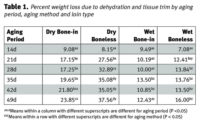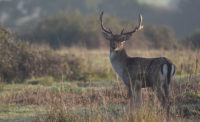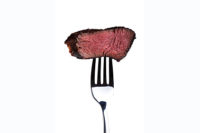Tech | Meat Science Review
Product yield, fatty acid content of N.D. wild game

There is a growing interest in the holistic nature of harvesting wild game. Previous research has shown that the harvest of game animals is an important tool in environmental conservation and serves as a means for promoting animal biodiversity. Furthermore, additional research suggests the progression of chronic disease in human populations was a result of an evolutionary decline in the consumption of lean and fat tissue from wild grazing ruminants, in favor of commercial industrial animal farming.
Hunters, in collaboration with wildlife clubs and the North Dakota Game and Fish Department, were recruited to deliver their field-harvested game animals to the North Dakota State University (NDSU) meat laboratory in Fargo for processing. Twenty-nine mule deer (MUL), 32 moose and 21 elk were received for analysis. The animals were harvested using bow, rifle or muzzleloader as regulated by the North Dakota Game and Fish licensing laws. Hunters were provided with a heavy-duty plastic bag to retain the entrails to accompany the field-dressed carcass to the NDSU meat laboratory. The carcasses were kept in a 3°C cooler until processing (1 to 3 d). One longissimus muscle (LM) sample (approximately. 454 grams) was taken adjacent the 12th and 13th thoracic vertebra from each carcass for proximate analysis. Each individual muscle sample was frozen, lyophilized and stored at minus-18°C. A portion of each lyophilized LM sample was sent to the USDA Grand Forks Human Nutrition Research Center for fatty acid analysis based on AOAC #996.06.
The LM from MUL had a greater percentage protein than moose and elk (P < 0.001; Table 1). The three species differed from each other in content of crude fat and kcal/100 g of meat sample (P < 0.013) with MUL possessing the greatest percentage of fat and energy, whereas elk and moose did not differ. Mule deer possessed greater content of cholesterol/100 g of meat sample (P < 0.001), followed by elk, then moose. With regard to saturated fatty acids, elk had the highest percentage of myristic (14:0; followed by MUL then moose) and palmitic acid (16:0; followed by moose and MUL which did not differ), yet the elk had the lowest content of stearic acid (18:0) followed by moose, then MUL. Regarding mono-unsaturated fats, elk possessed a greater content of myristoleic (14:1) and palmitoleic acid (16:1) than MUL or moose, which did not differ. That said, elk had the lowest concentration of oleic acid (18:1)/100 g of muscle, which differed from MUL (highest 18:1 concentration) and moose. Each species differed from the other for LM content of poly-unsaturated fatty acids with moose possessing the greatest percentage of linoleic (18:2) and arachidonic acid (20:4), which differed from elk, which differed from MUL. Mule deer had a greater content of a-linolenic acid (ALA; 18:3) than elk and moose, which did not differ.
Mule deer had the greatest concentration of oleic acid; elk the lowest. A project conducted by Japanese restaurants evaluating consumers of wagyu beef noticed that an increase in marbling did not generate a greasy mouth feel, but rather was described as “melt-in-the-mouth beef” that possessed a pleasant taste. Torigoe (2009) concluded that the key to succulent palatability was associated with the high percentage of oleic acid present in the intramuscular fat. Further, the “melt-in-the-mouth” palatability trait increased as the content of oleic acid increased in the beef. This impact of oleic acid on palatability perception may not be as pronounced in low-fat meats such as those evaluated in the present study. Although the exact geographic location and the agriculture landscape is not known for each game animal harvested, North Dakota MUL habitat is often in closer proximity to land used for crop production. Therefore, the increased content of oleic acid seen in the MUL population of this study could have been consuming more corn. The NIH (2019) recommends an “adequate intake” of omega-3 fatty acids to be 1.6 and 1.1 g/d for men and women (respectively) ages 14 and older. In the current study, 100 g of LM from MUL would provide the greatest amount of ALA at 70.4 mg, with elk and moose providing less (Table 1). With the small amount of fat present in the tissue of the LM samples in the present study, it is unlikely that consumption of nominal amounts of these species would result in improved health benefits associated with omega-3 fatty acids (Shahidi and Ambigaipalan, 2018).
Game meat is an alternative source of animal protein. All three species evaluated in this study had more than 22 g protein/100 g of lean tissue. In 2017, ND hunters harvested 2,101 MUL, 221 moose and 211 elk. Calculating the average weight of bulls and cows and adding the percent of edible lean, North Dakota averaged 28,682 kg for MUL, 23,571 kg moose and 13,648 kg elk. The Dietary Reference Intake (Institute of Medicine of the National Academies of Science) suggests men 19 to 70 years old should consume 56 g/d of protein and women ages 14 to 70 consume 46 g/d (0.8 g/kg of body weight; U.S. Department of Health and Human Services). Based on these numbers, the amount of edible product generated from the harvest of MUL in ND could provide the average recommended daily allowance of high-quality protein to 1,000 mature American women for 623 days and 1,000 American men for 512 days. Likewise, the ND elk and moose harvest could feed 1,000 American men for 665 days. NP
To read the full research article, visit https://www.iastatedigitalpress.com/mmb/article/id/9077/
Looking for a reprint of this article?
From high-res PDFs to custom plaques, order your copy today!





